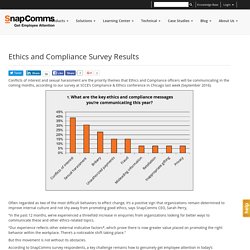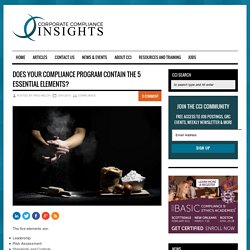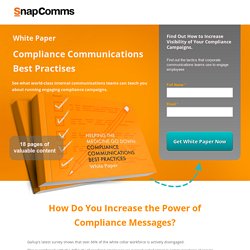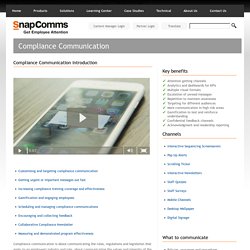

Ethics and Compliance Survey Results. Conflicts of interest and sexual harassment are the priority themes that Ethics and Compliance officers will be communicating in the coming months, according to our survey at SCCE’s Compliance & Ethics conference in Chicago last week (September 2016).

Often regarded as two of the most difficult behaviors to effect change, it’s a positive sign that organizations remain determined to improve internal culture and not shy away from promoting good ethics, says SnapComms CEO, Sarah Perry, “In the past 12 months, we’ve experienced a threefold increase in enquiries from organizations looking for better ways to communicate these and other ethics-related topics. “Our experience reflects other external indicative factors*, which prove there is now greater value placed on promoting the right behavior within the workplace. There’s a noticeable shift taking place.” But this movement is not without its obstacles. Sarah Perry agrees. Social Media, Mobile Prove Too Much for Compliance Officers. Compliance professionals are struggling to keep up with the explosion of communications channels, including social media and mobile devices, according to the latest Electronic Communications Compliance Survey Report from Smarsh.

The company’s sixth annual compliance survey reveals that gaps in enforcement, retention and policies remain very high, exposing firms to the risks of undetected fraud, errors and regulatory enforcement actions. The primary purpose of electronic message supervision is to fulfill regulatory requirements designed to protect investors, such as SEC rule 17a-4, which requires firms to archive electronic business communications in non-rewriteable and non-erasable (WORM) formats for at least three years.
In addition to retention, firms are required to perform risk-based review of correspondence and internal communications. Meanwhile, social media is the communication channel representing the highest perceived level of risk, cited by almost 50% of respondents. Will your compliance program lose you your job? Does Your Compliance Program Contain the 5 Essential Elements? The five elements are: LeadershipRisk AssessmentStandards and ControlsTraining and CommunicationsOversight Leadership This point means more than the “tone at the top; a successful compliance program must be built on a solid foundation of ethics that are fully and openly endorsed by the company’s senior management.

Management’s commitment to compliance should be unambiguous, visible and active. Even more important than support or the right tone, compliance standards require companies to have a high-ranking compliance officer with the authority and resources to manage the program on a day-to-day basis. Valuable questions regarding the leadership of a compliance program are: How is Board oversight implemented? The Board of Directors has an equally key role to fulfill. Risk Assessment The implementation of an effective compliance program is more than simply following a set of compliance regulations or providing effective training. What are some of the areas where you need to assess your risks? Survey finds firms need to 'mind the gap' in e-communications compliance. The volume of data associated with communications in the financial services sector has exploded in recent years.

But as firms allow communication to take place across more channels, a recent survey from Smarsh finds compliance efforts are not keeping pace. Nearly one-third (32%) of firms that allow business communication through employees’ personal social media accounts do not have supervision or social media archiving solutions in place to monitor those messages. The compliance gap doubles to 64% when it comes to text messages – even as regulations call for the timely capture and production of e-communications upon request. “You’ve got advisors and brokers communicating with their customers and communicating with business partners in the office all over text messaging because it is easy and its everywhere.
The problem is most organizations don’t have the means to capture, archive or reproduce those communications,’ explains Smarsh founder and CEO Stephen Marsh. Compliance - SnapComms. White Paper Compliance Communications Best Practises Gallup’s latest survey shows that over 66% of the white collar workforce is actively disengaged.

This is combined with the difficulty of reaching employees via oversaturated internal communications channels such as email and your corporate intranet. So, how do you increase employee engagement with your compliance communications programs? Compliance Communication. Compliance Communication Introduction Compliance communication is about communicating the rules, regulations and legislation that apply to an employee's industry and role, about communicating the values and integrity of the organization and about helping employees know how to do the right thing (which of course also means communicating what the right thing is and the process to do the right thing).

It is also a way to demonstrate to all stakeholders (internal and external) a commitment to honesty and responsible behaviour. Bor…ring! Do you use tired old emails, eLearning initiatives that are too long, an internet site that few visit and even less that actually engage with? CEB research shows that 68% of employees fail to engage with compliance training. Compliance screensaver Example Customising and targeting compliance communications Special interest groups– SnapComms also allows you to target messages to specific interest groups regardless of their physical location.